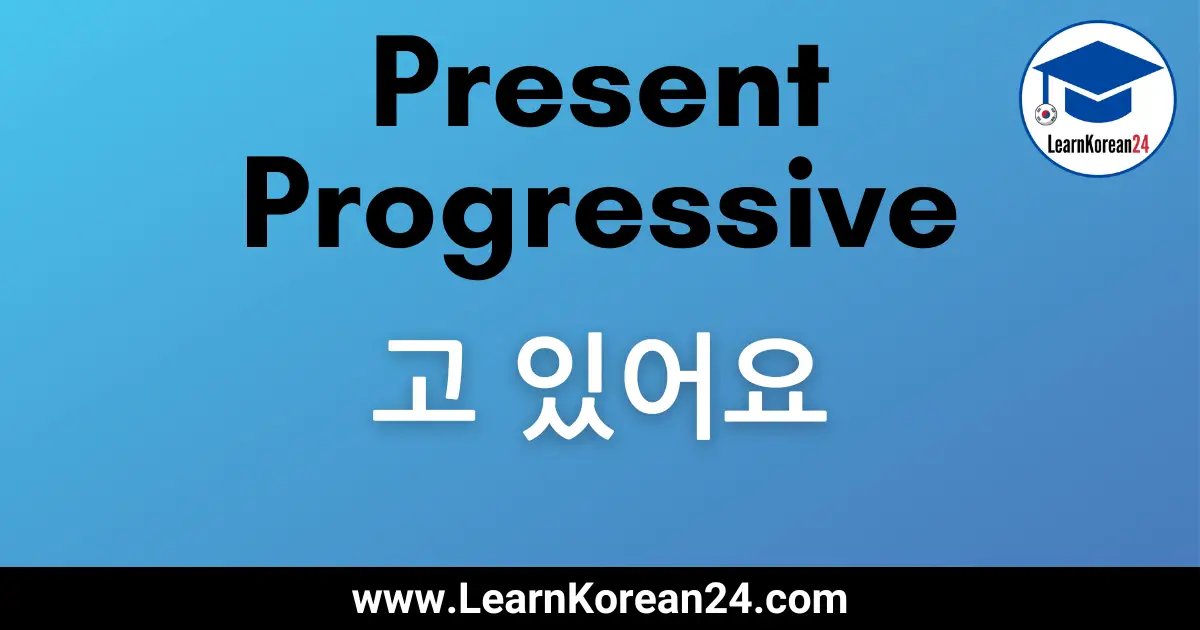Korean Present Progressive Tense | ~ 고 있어요
In this lesson, you will learn how to make the Korean present progressive tense. If you’re not sure what the present progressive tense is, it is a tense which is used to describe a continuous action that is happening now. In English. the present progressive tense is formed by adding -ing to a verb. For example, ‘He is eating‘, ‘She is reading.’, etc.
Below you will learn how to change verbs into the Korean present progressive tense and how to make Korean present progressive tense sentences. You’ll also use what you learned in previous lessons on the past tense and future tense to make past progressive sentences and future progressive sentences in Korean.
Present Progressive Tense In Korean
Before we look at the Korean present progressive tense conjugation, there is one important thing you should know. Many people in everyday Korean conversation simply use the present tense form to indicate the present progressive tense, especially if it is clear from the context that you are referring to something happening now.
For example, if you wanted to ask ‘What are you doing now?’ in Korean, you can use the present progressive form (지금 뭐 하고 있어요?), but it is much more common to simply use the present tense form (지금 뭐 해요? = literally ‘Now what do?’). With that important information out of the way, let’s learn how to make the Korean present progressive tense.
Korean Present Progressive Tense (~고 있어요)
To make the Korean present progressive tense you simply attach ~고 있어요 to a verb stem. ~고 있어요 comes from the stem ~고 있다 (to be -ing). When ~고 있다 is conjugated into the present tense it becomes ~고 있어요. Let’s look at some examples.
| Korean | English | Listen |
|---|---|---|
| 보다 | to see/watch | |
| 보고 있다 | to be watching | |
| 보고 있어요 | watching | |
| 저는 영화를 보고 있어요. | I am watching a movie. | |
| 자다 | to sleep | |
| 자고 있다 | to be sleeping | |
| 자고 있어요 | sleeping | |
| 수민이 자고 있어요. | Sumin is sleeping. |
Korean Past Progressive Tense (~고 있었어요)
In a previous lesson, we covered how to conjugate verbs in the past tense. To make the past progressive tense, you simply conjugate ~고 있다 (to be -ing) into the past form and then attach it to a verb stem. 고 있다 in the past form is ~고 있었어요, and attaching this to a verb stem changes it into the past progressive form.
Let’s look at some examples.
| Korean | English | Listen |
|---|---|---|
| 듣다 | to listen | |
| 듣고 있어요 | listening | |
| 듣고 있었어요 | was listening | |
| 아까 음악을 듣고 있었어요. | I was listening to music earlier. | |
| 생각하다 | to think | |
| 생각하고 있어요 | thinking | |
| 생각하고 있었어요 | was thinking | |
| 엄마를 생각하고 있었어요. | I was thinking about my mother. |
Korean Future Progressive Tense (~고 있을 거예요)
If you remember how to make the future tense, making the future progressive tense is quite simple.
To make the future progressive tense you simply attach ~고 있을 거예요 to a verb stem. As you can see, this is ~고 있다 conjugated in the future tense. Let’s look at some examples:
| Korean | English | Listen |
|---|---|---|
| 공부하다 | to study | |
| 공부하고 있어요 | studying | |
| 공부하고 있었어요 | was studying | |
| 공부하고 있을 거예요 | will be studying | |
| 집에 도착할 때 저는 공부하고 있을 거예요. | I’ll be studying when you arrive home. | |
| 일하다 | to work | |
| 일하고 있어요 | working | |
| 일하고 있었어요 | was working | |
| 일하고 있을 거예요 | will be working | |
| 집에 도착하면 저는 일하고 있을 거예요. | I’ll be working when you arrive home. |
Are you ready to get serious about learning Korean? Start our 100% FREE online Korean language course today!

